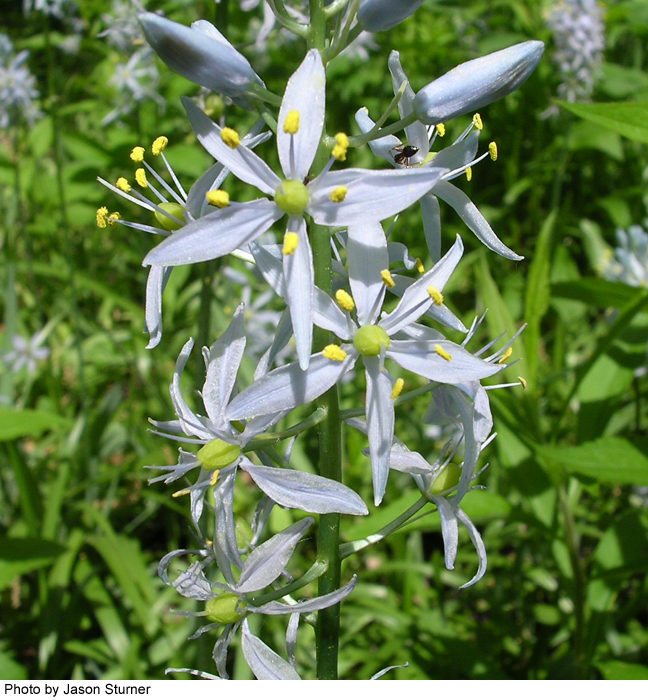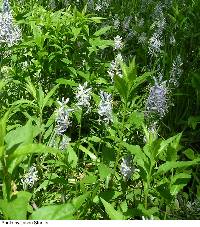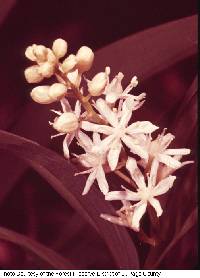|
|
|
|
Family: Asparagaceae
Atlantic camas
[Oxytria texana (Scheele) Pollard, moreQuamasia hyacinthina (Raf.) Britton, Schoenolirion texanum (Scheele) A.Gray] |
Bulbs sometimes clustered, ovoid, 1-3 cm diam. Leaves 3-8, 2-6 dm × 5-20 mm. Inflorescences 19-47 cm; sterile bracts 0-3(-5), bracts subtending flowers shorter than or equaling pedicel. Flowers actinomorphic; tepals usually withering separately after anthesis, not deciduous, light blue, occasionally whitish, each 3- or 5-veined, 7-15 × 2.6-4.2 mm; anthers bright yellow, 1.3-3.2 mm; fruiting pedicel mostly spreading to spreading-erect, 5-30 mm. Capsules deciduous, pale green to light brown, subglobose, 6-10 mm. Seeds 2-5 per locule. 2n = 30. Flowering mid--late spring. Prairies; 100--1000 m; Ont.; Ala., Ark., Ga., Ill., Ind., Iowa, Kans., Ky., La., Md., Mich., Miss., Mo., Ohio, Okla., Pa., S.C., Tenn., Tex., Va., W.Va., Wis. Camassia scilloides flowers two to three weeks earlier than sympatric populations of C. angusta. The name Schoenolirion texanum was long misapplied to a taxon now correctly known as S. wrightii Sherman.
Perennial herb with bulbs flowering stem 30 cm - 0.6 m tall Leaves: basal, appearing whorled, 20 - 40 cm long, 5 - 10 mm wide, linear, keeled. Inflorescence: a terminal, elongated, and many-flowered cluster (raceme) raised on a single stalk. Flowers: on 1 - 2 cm long, spreading stalks, pale violet or blue to white, 7 - 12 mm long, mostly radially symmetrical, with six spreading, lance-shaped tepals that wither but remain during fruit. Stamens six. Anthers yellow. Fruit: a rounded, dehiscent capsule. Bulbs: solitary or clustered, 1 - 3 cm thick, somewhat round, and encased in a brown or black coating (tunic). Similar species: Camassia scilloides is a distinctive plant in the Chicago Region. Flowering: May to mid-June Habitat and ecology: Found in prairies, savannas, woodland borders, and mowed fields near woods. Occurence in the Chicago region: native Notes: There are several species of Camassia cultivated from the native species. Etymology: Camassia comes from the Native American word quamash, meaning sweet. Scilloides means "resembling plants from the Genus Scilla." Author: The Morton Arboretum Bulb 1-3 cm thick; lvs 2-4 dm נ5-10 mm; scape 3-6 dm, rather stout; raceme many-fld; pedicels 1-2 cm, spreading, about equaling the filiform bracts; tep blue or pale violet to white, 7-12 mm, withering and persistent at the base of the subglobose, transversely veined fr. Prairies and moist open woods; w. Pa. and s. Ont. to s. Wis. and e. Kans., s. to Ga. and Tex.; sometimes casually escaped elsewhere. Apr., May. (C. angusta; Quamasia hyacinthina) Gleason, Henry A. & Cronquist, Arthur J. 1991. Manual of vascular plants of northeastern United States and adjacent Canada. lxxv + 910 pp. ©The New York Botanical Garden. All rights reserved. Used by permission. |




